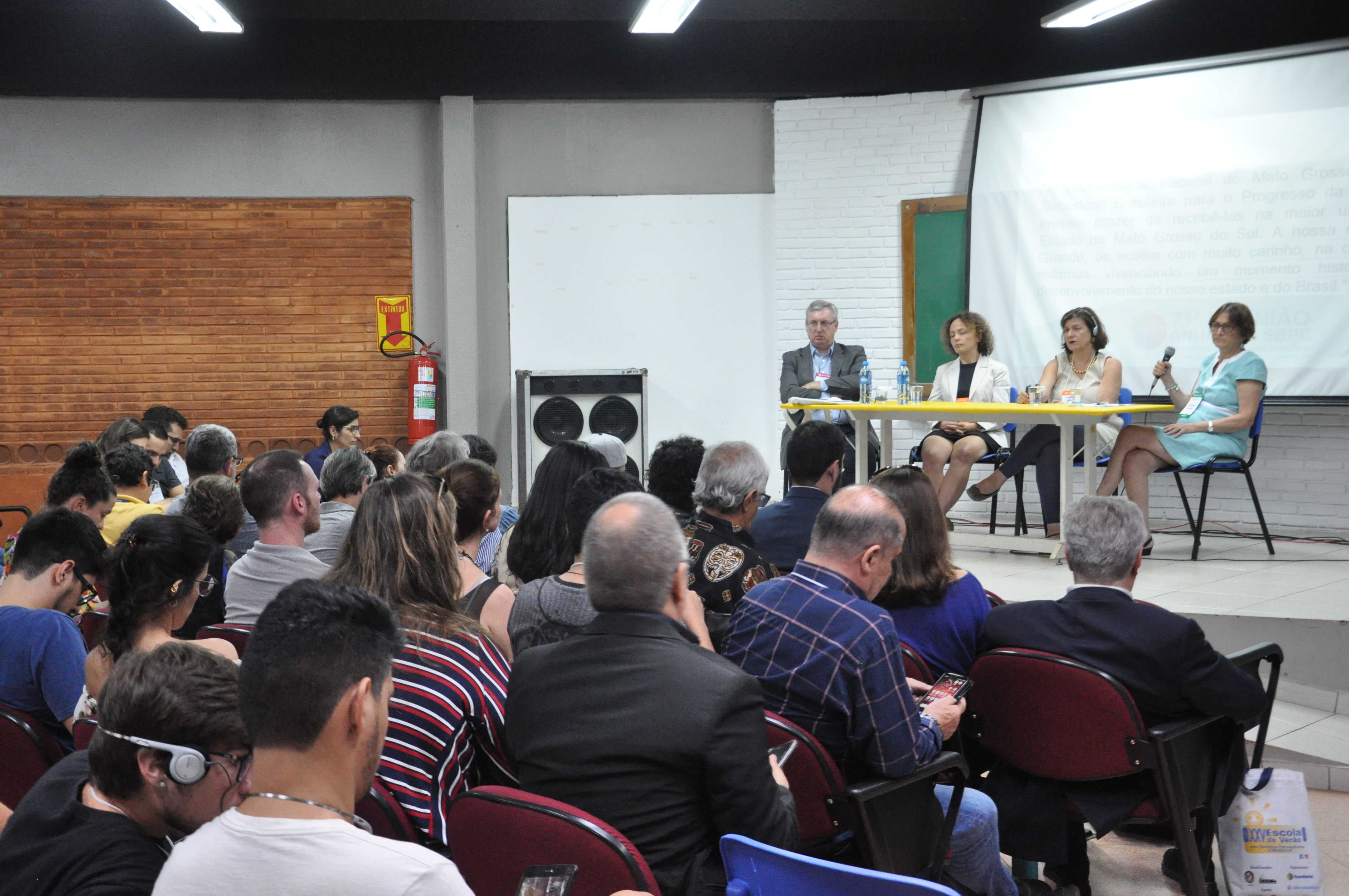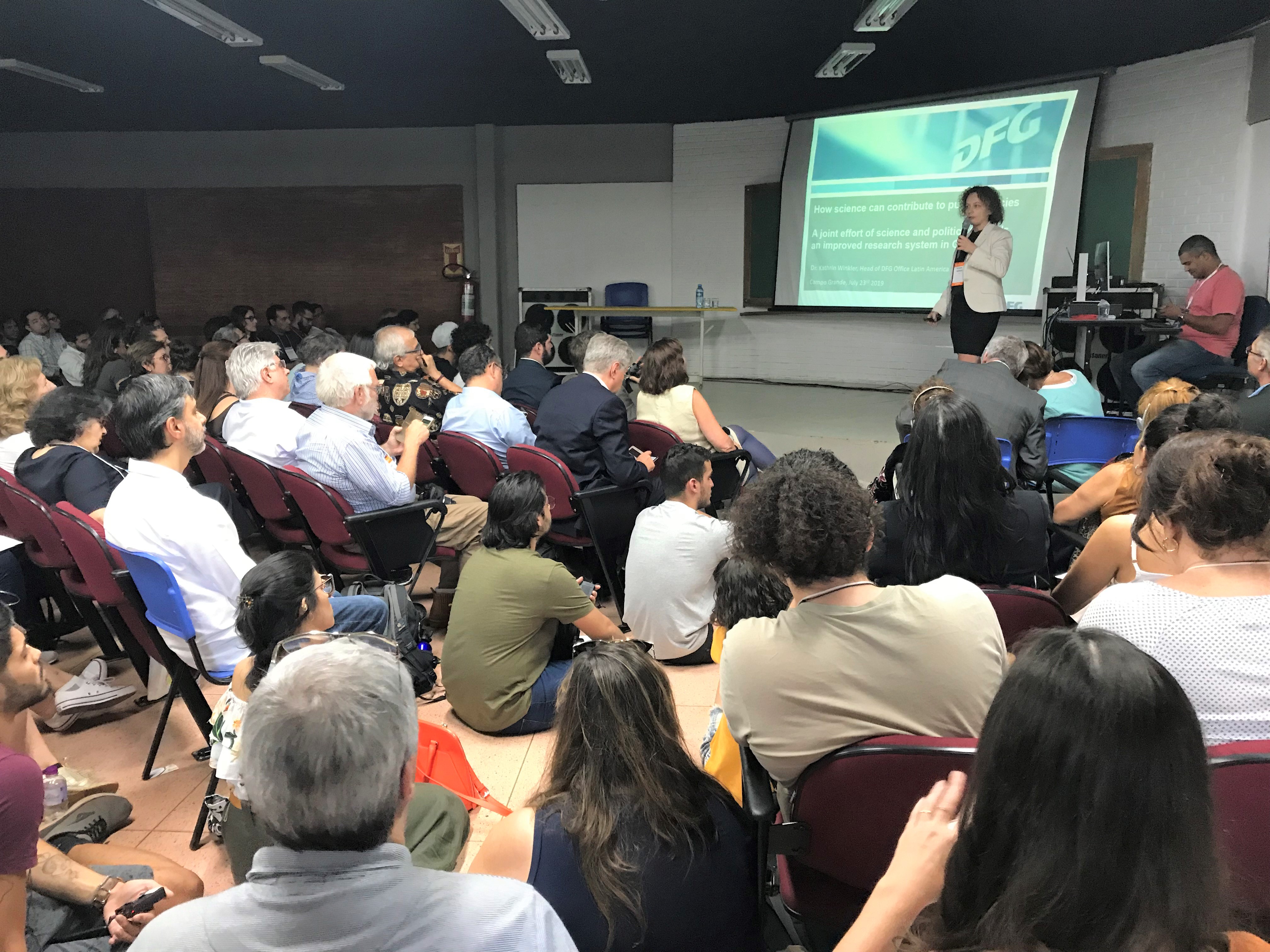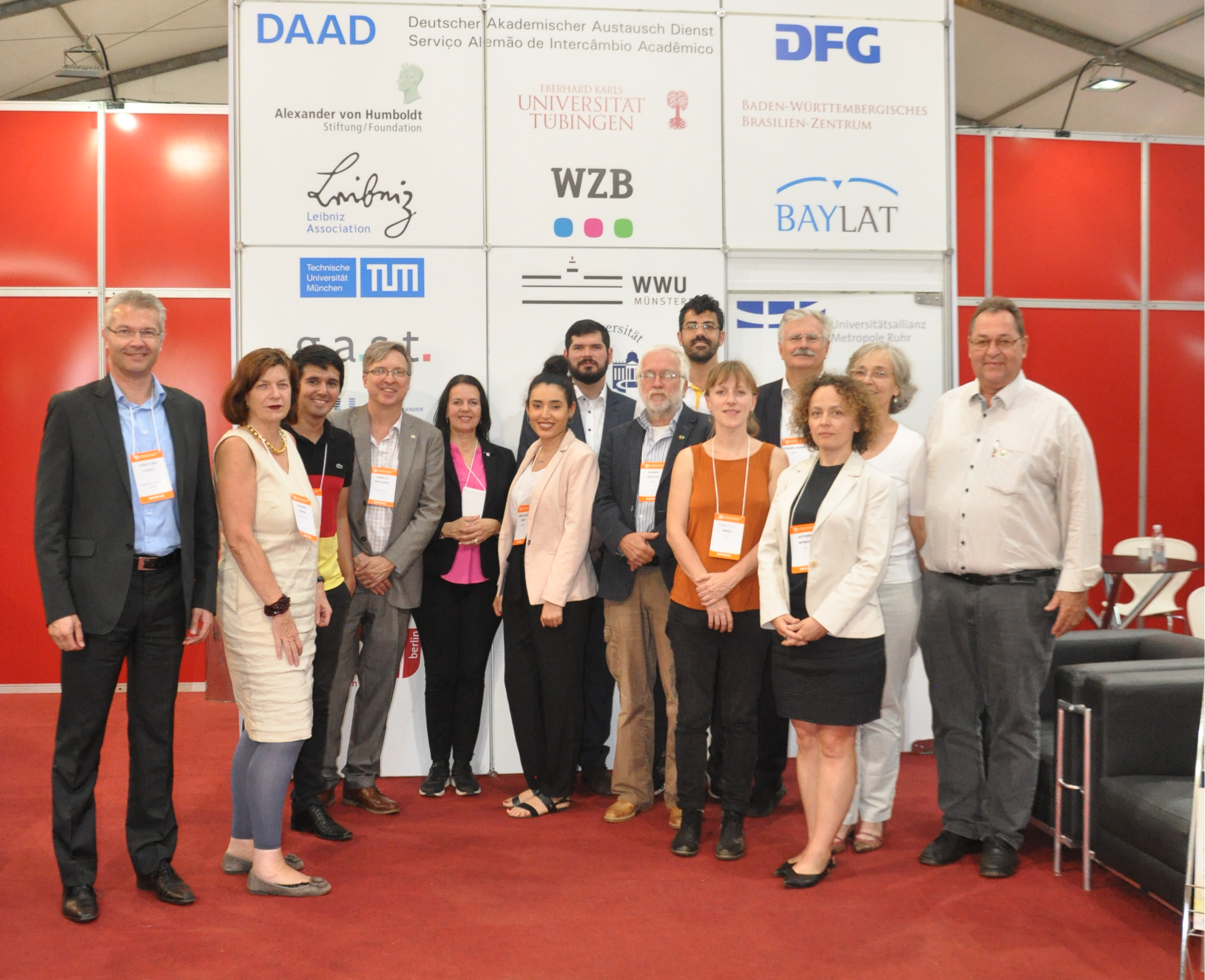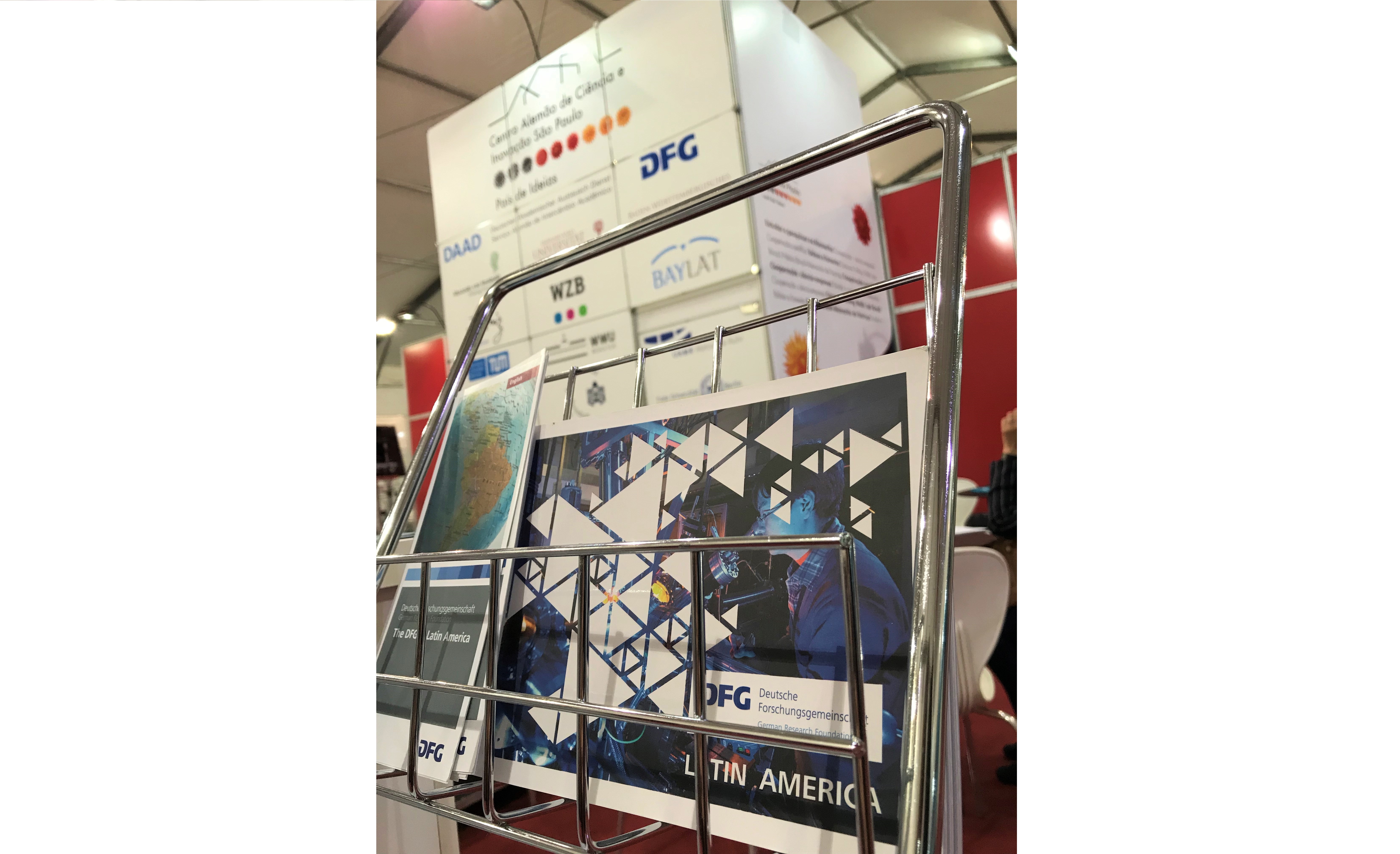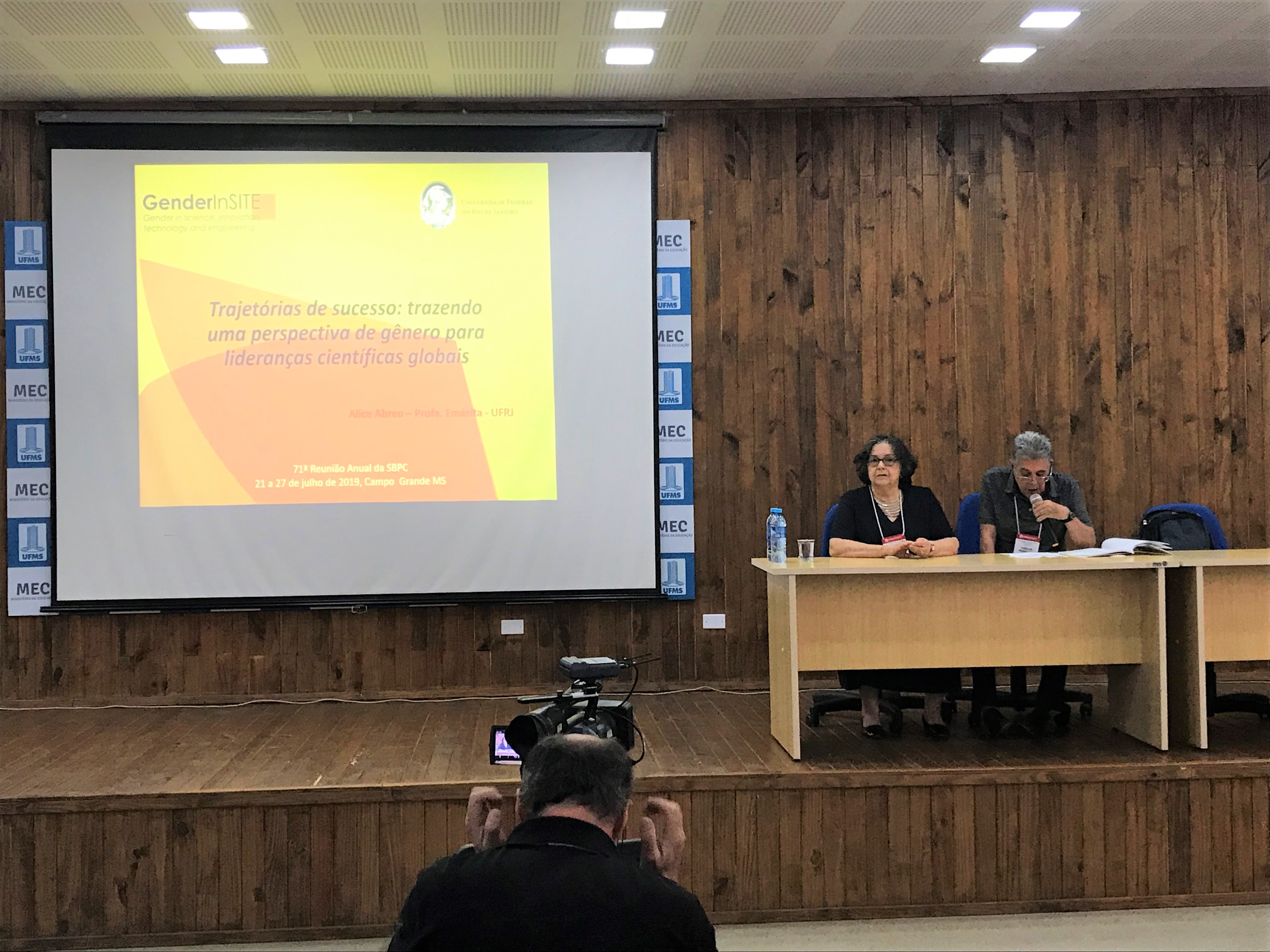DFG diskutiert Wissenschaftspolitik bei SBPC-Jahrestagung in Campo Grande
(20.08.19) Which German site features a telescope for which the steel structure was designed in São Carlos? What is the current status of postgraduate studies in Brazil? How should measures for promoting equal opportunities in science be evaluated? What contribution can science make to more effective science policies?
These and many other questions were debated during the 71st annual meeting of the Brazilian Society for the Advancement of Science (Sociedade Brasileira para o Progresso da Ciência – SBPC) in Campo Grande. The event took place at the Federal University of Mato Grosso do Sul (UFMS), at which 1,300 teaching staff currently supervise a total of 21,000 students in undergraduate and postgraduate studies.
The SBPC audience follows the panel discussion on the contribution made by science to science policy
© DWIH São Paulo
The central theme chosen for the meeting was “Science and innovation on the boundaries between bioeconomics, diversity and social development”. Among the 30,000 or so participants were students and early career researchers, as well as experienced researchers and representatives of the science and technology sector. The wide-ranging programme comprised 180 symposia, panel discussions, meetings and lectures as well as 600 poster presentations and more than 50 cultural attractions. Representatives of the DFG Office Latin America took part in the event as part of a delegation coordinated by the German House for Research and Innovation (DWIH) São Paulo.
On the afternoon of 23 July, the DWIH São Paulo and the SBPC held a panel discussion on the interaction between science and politics, in which the Director of the DFG’s Latin America office, Dr. Kathrin Winkler, also participated. In her talk, she illustrated the contribution that science can make to science policy questions, using the DFG as an example. The DFG with its responsibilities, structure and funding philosophy plays an important role as a self-governing organisation of science in the heterogeneous German funding system. One example of this is its participation in the implementation of the Excellence Strategy, which is designed to boost the international visibility of German research. One of the objectives of this measure is to consolidate Germany’s standing as an attractive research location. According to Winkler, the initiative resulted in greater internationalisation of the German research system and improved career opportunities at universities.
As part of the evaluation of its predecessor programme, the Excellence Initiative, aspects in need of improvement were also listed, in particular with respect to the training of early career researchers and administrative structures at research institutions. The recommendation of the expert committee was that the main focus be placed on scientific excellence, which resulted in the three original funding lines being limited to two. Currently, the Cluster of Excellence and Universities of Excellence funding lines are financed as part of the Excellence Strategy.
Other presenters in the panel discussion were the former Minister of Science, Celso Pansera, and researcher Dr. Dagmar Simon of the Social Science Research Center Berlin; the session was moderated by former SBPC President, Prof. Dr. Helena Nader.
In the topic block “Prospects for postgraduate studies in Brazil”, CAPES President Prof. Dr. Anderson Correia emphasised that the number of programmes, enrolments and completed degrees had doubled between 2006 and 2017. Following this considerable growth, the DFG partner organisation now intends to pursue qualitative improvements, with strategies that include heightening the impact of implemented projects and research cooperations with industry. The CAPES evaluation, which takes place every four years, resulted in restructuring measures, with international cooperation being assigned a key role in the process. Correia noted that for this reason the PrInt internationalisation programme continues to be a priority and will be continued in its second phase from 2021.
The role and importance of Brazil in the international research landscape was discussed during the session entitled “Significant international cooperation projects in the Brazilian science sector”. Brazilian researchers were involved in the three outstanding scientific discoveries of recent years: proof of the Higgs boson in 2012, gravitational waves in 2015 and the first photograph of a black hole this year. Initiatives in the field of astronomy were presented, for example the development of telescopes for the Cherenkov Telescope Array (CTA) gamma-ray telescope, which is to be installed in Chile and on the Canary Islands. These regions provide outstanding atmospheric conditions and characteristics for astronomical observation. The prototype of a medium-sized telescope, of which a total of 25 are to be used as part of the project, was installed at the Deutsches Elektronen-Synchrotron (DESY) in Zeuthen. The metal structure onto which the camera is fixed was developed by Brazilian company Orbital Engenharia under the oversight of Prof. Dr. Luiz Vitor de Souza Filho of the Institute for Physics (IFSC) in São Carlos with funding from the FAPESP. The presenters reiterated that funding needs to be made available on an ongoing basis to ensure effective participation by Brazilian researchers in future projects of this magnitude. They also believed that long-term investments and partnerships with businesses and industry are required.
A further item on the programme of the SBPC annual meeting was equal opportunities in science, and Prof. Dr. Alice Abreu of the Federal University of Rio de Janeiro (UFRJ) gave a lecture on that topic. “In academia, the career steps of male and female researchers develop differently, which is due to the fact that academic systems are not neutral and men's expectations and roles can fit into those systems better,” the expert explained in her introduction. She then proceeded to introduce fundamental aspects of the report “Pathways to Success: Bringing a Gender Lens to the Scientific Leadership of Global Challenges“ compiled by the GenderInSITE Initiative. The publication is based on interviews with male and female scientists who run international research projects, and investigates the obstacles to the required changes at various levels – starting with researchers as individuals, the institutional structures at their workplaces, national and international strategies and measures, all the way through to multilateral organisations such as the UN or UNESCO.
The SBPC, which was founded in 1948, is dedicated to fostering scientific and technological progress and promoting education and culture in Brazil. It currently has 142 scientific member societies from all branches of knowledge and around 5,000 active members. The annual meeting of the SBPC takes place every year at a public university in a different Brazilian Federal state – several thousand attendees gather regularly for the occasion to discuss scientific topics and to enter into dialogue with the public on scientific findings in a range of fields.
